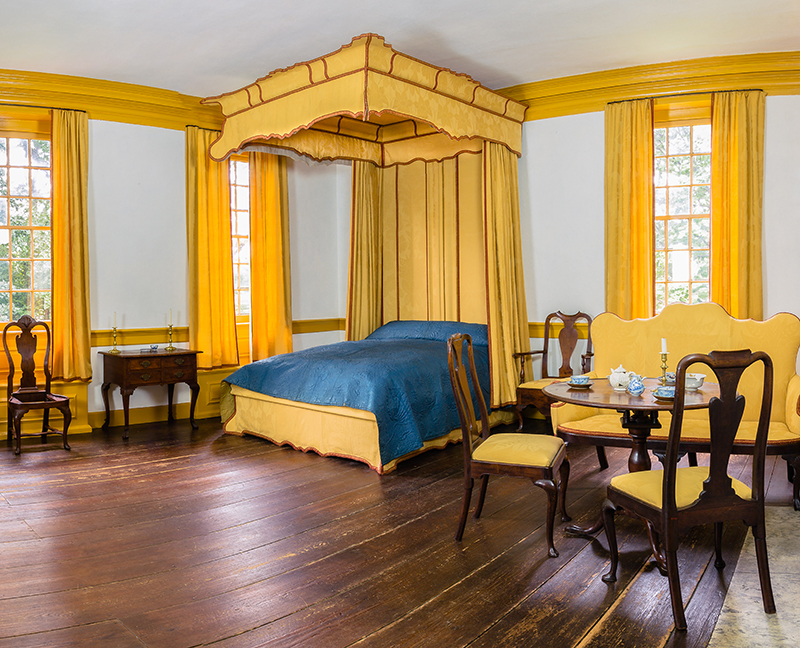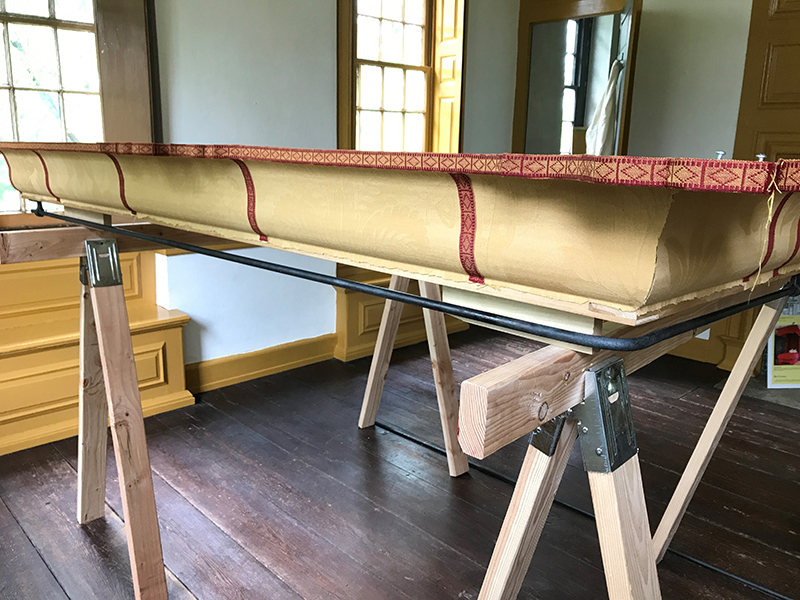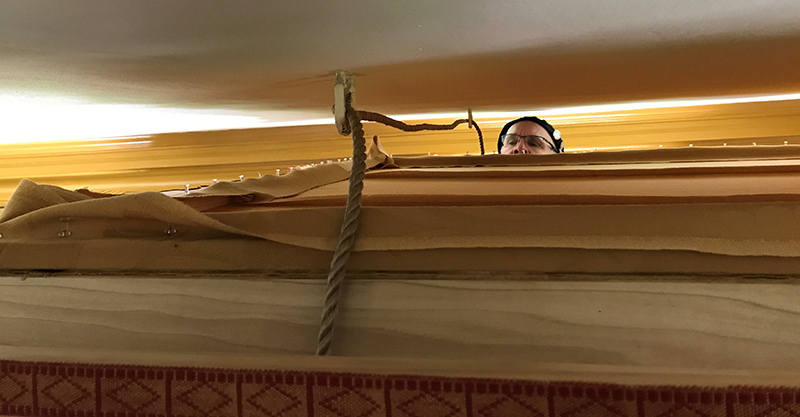Hooked on Beds: Stenton’s Re-created Flying Tester Bedstead
by Laura C. Keim
Original iron hooks embedded in second-floor chamber ceilings at Stenton pose questions about bedstead types while confirming their locations. A 1752 probate inventory recorded a “Yellow Worsted Damask Bed wth Curtains, Window Curtains & Bed Cloaths &c” worth £30 that furnished Stenton’s Yellow Lodging Room1. Offering a clear description of the textile—a yellow wool damask—but silent on wood, the inventory suggests an invisible substructure under the damask and poses restoration questions: how big a damask, and what was the actual appearance of that yellow?
In 2017, Stenton, the c. 1730 gentleman’s house built for Quaker colonial statesman James Logan (1674–1751) near Philadelphia, restored the Yellow Lodging Room (figure 1). The re-creation is based on physical investigation of the room, contextualizing visual sources, surviving examples of flying tester bedsteads, and some creative design choices. Visual evidence comes from a variety of English sources, including prints, such as designs for earlier aristocratic state bed chambers by Daniel Marot, and a 1729 sketch by antiquarian William Stukeley of his own bedchamber at Grantham in Lincolnshire. A flying tester bedstead installed at Handel House Museum in London in 2005 and miniature examples in the Nostell Priory and Uppark baby houses in National Trust collections served as physical models.
The process included re-creating paint finishes, analyzing the dye of a Logan quilt, investigating the Logan settee at The Metropolitan Museum of Art, purchasing yards of newly woven “Lady Penn Damask,” and acquiring a diamond-design tape to cover seams and finish lead edges of curtains. The pièce de resistance is the entirely new flying tester, also known as an “angel” bedstead, wherein the foot-end of the tester frame is suspended from hooks, hidden by the bed cornice, thereby creating a “ceiling” over the bed that supports the rods and curtains (figures 2 and 3).
Developing the Stenton bedstead started with careful documentation and measurement of a rare surviving early 18th-century softwood cornice at Walnford in Monmouth County, NJ, which we copied.2 The size and scale of the cornice, the Lodging Room’s proportions, comparisons with other 18th-century bedsteads, and scaling from Stukeley’s sketch generated the measurements and plan for the bedstead built from tulip poplar. The wool damask upholstery, hide-glued to the shellacked poplar back panels and cornice, entirely obscures the bedstead’s wood components.
The economic value of a flying tester bedstead was almost completely in its textiles (so long as it remained usable and fashionable) because there was no elegantly carved walnut or mahogany on display. Because their dimensions fit the scale of a specific room, these bedsteads were difficult to relocate, and a wool upholstery glued to the wooden substrate would have become worn and moth-eaten.
Flying tester bedsteads are not obviously indicated on probate inventories.3 They may have been known in the period as “Screw Bedsteads.” Jay Stiefel suggests that Philadelphia Cabinetmaker John Head’s note of “Comperst Rods…hoks & 2 scrues…” refers to an angel bed.4 Jonathan Dickinson’s 1722 probate inventory, valued at over £907, lists “Screw Bedsteads & Iron Rods.”5 The limited lifespan of upholstered softwood bedsteads may explain the dearth of surviving Philadelphia Queen Anne-era bedsteads.
Edward Cathrall and Hugh Roberts, who evaluated James Logan’s “Goods and Chattels” after his death, did not apply the term “screw bedstead.” Stenton retains the physical evidence of the ceiling hooks, but no other clues to suggest the form of the bedsteads. I struggled with the question of whether the hooks provide sufficient evidence to justify the re-creation of the flying tester bedstead form, ultimately deciding in favor of the project. Stenton’s choice to present and interpret a rarely surviving bedstead form is an important one for the American decorative arts field. To my knowledge, Stenton’s flying tester bedstead is the only one to be seen in an American historic house museum. As a result, it is well worth a visit to Stenton to view the bedstead and the completed room in person.
1 Edward Cathrall and Hugh Roberts, Inventory Taken at Stenton of Goods and Chattels belonging to ye Estate of James Logan Deceased. August, 1752. Original missing from the City of Philadelphia Archives; photostatic copies available at Stenton and in the Logan Papers at the Historical Society of Pennsylvania.
2 The precise provenance of the Walnford cornice is undocumented. It sits atop a later four-poster bedstead, all elements painted gray. The Baroque curves and bold projecting corners of the cornice suggest its origin in the first half of the 18th century. If the de-upholstered soft wood cornice indeed descended in the Waln family, their status as a high-ranking, Philadelphia-based, Quaker mercantile family supports use of this cornice as a basis for the re-created flying tester bedstead.
3 As for hooks, there are other houses with bed hooks and some that had built-in cornices in mid-Atlantic contexts. Ralph Harvard shared photos of architectural cornices set into the plaster ceiling of a third-floor unheated chamber at Westover, built c. 1750 in Eastville, VA, and from Pemberton Hall built 1741 in Salisbury, MD, which features pendant bobbins at the cornice corners to hold iron curtain rods. A period room in the Baltimore Museum of Art displays a bed under a built-in painted cornice. The Bartram House in Philadelphia has four hooks for a tester in the chamber over the study. The Newbold family farmhouse near Chesterfield, NJ, has round iron hooks in the ceilings of two bed chambers in a 1769 addition to the house, and the 1774 Isaac Haines House in Cecil County, MD, Lot 8 of the Nottingham Tract, has four square-cornered iron hooks in the ceiling of one of its chambers.
4 Jay Robert Stiefel, The Cabinetmaker’s Account: John Head’s Record of Craft and Commerce in Colonial Philadelphia, 1718–1753 (Philadelphia: The American Philosophical Society Press, 2019), 200.
5 Will and Probate Inventory for Jonathan Dickinson. Philadelphia City Archives, Will Book D, 251.
Laura C. Keim is the Curator for Stenton in Philadelphia, PA and Lecturer in the Graduate Program in Historic Preservation at the University of Pennsylvania. For more information about the Yellow Lodging Room project, please see stenton.org/yellowroom, where you can find a complete list of craftspeople, suppliers, contractors, and funders. Laura shared treasures of Stenton with Trust members in two Object Share videos.
A print version of this article was published in The Magazine of the Decorative Arts Trust, one of our most popular member benefits. Join today!



